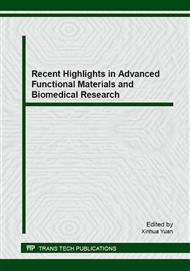p.3
p.7
p.11
p.15
p.19
p.23
p.29
p.33
Selective Sodium Removal from Lithium Chloride Brine with Novel Inorganic Ion Exchanger Li1.4Al0.4Ti1.6 (PO4)3
Abstract:
The powder of Li1.4Al0.4Ti1.6 (PO4) 3 has been synthesized by a solid phase reaction between Li2CO3, Al2O3, TiO2 and NH4H2PO4. Sodium removal was studied in an extensive series of tests involving different ionic exchange process variables such as time and temperature. The results indicate that the Na/Li ion exchange reaction rate increased obviously with increasing temperature, and the Na/Li ion exchange kinetics process of Li1.4Al0.4Ti1.6 (PO4) 3 in lithium chloride solution could be shown approximately by the equation of JMAK. Furthermore, it is concluded that the Na+-removed materials obtained from NASICON-type ceramics synthesized can serve as selective Na+ absorbent due to its high selectivity and larger ion exchange capacity.
Info:
Periodical:
Pages:
3-6
Citation:
Online since:
December 2014
Authors:
Keywords:
Price:
Сopyright:
© 2015 Trans Tech Publications Ltd. All Rights Reserved
Share:
Citation:


